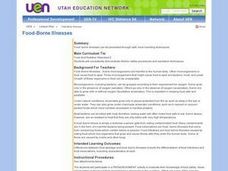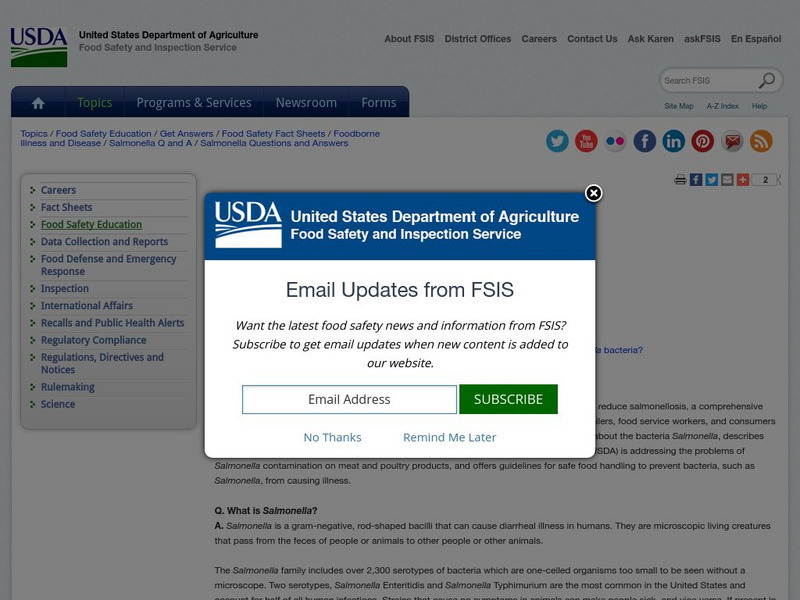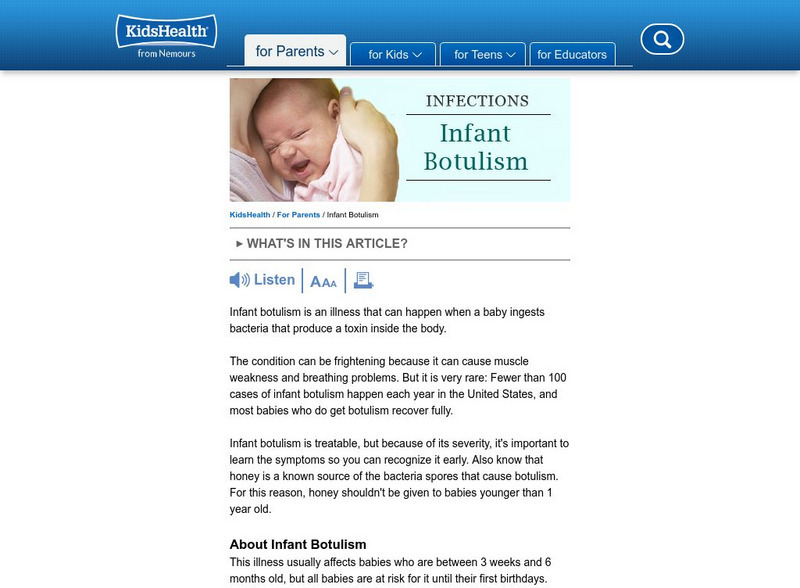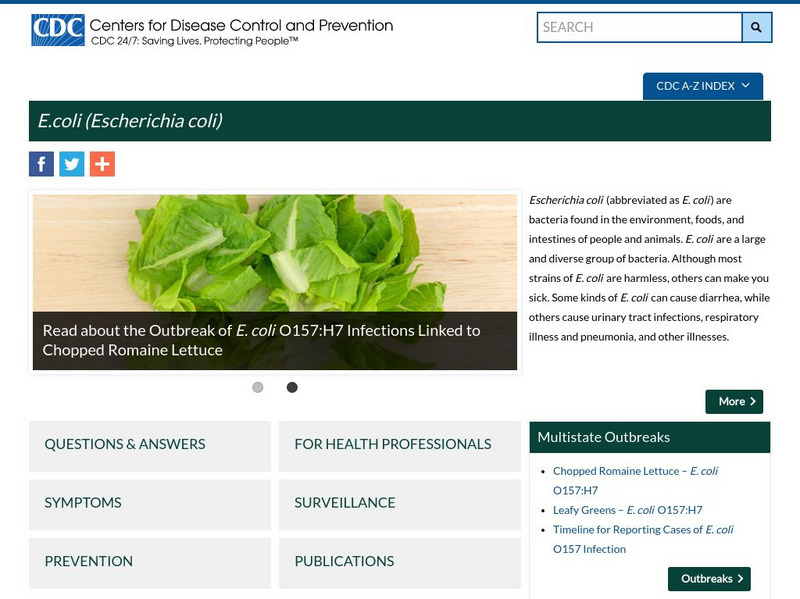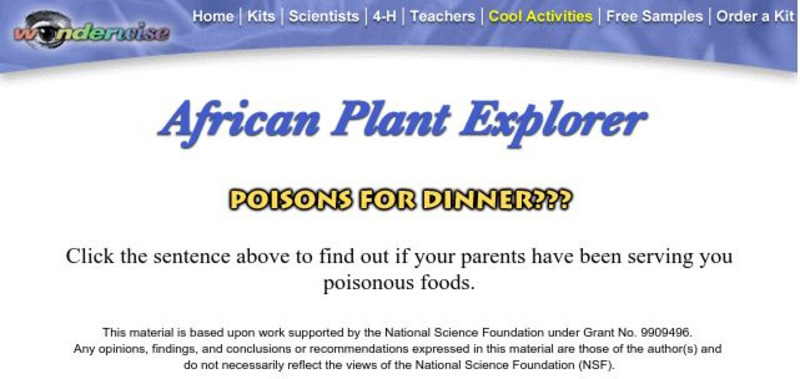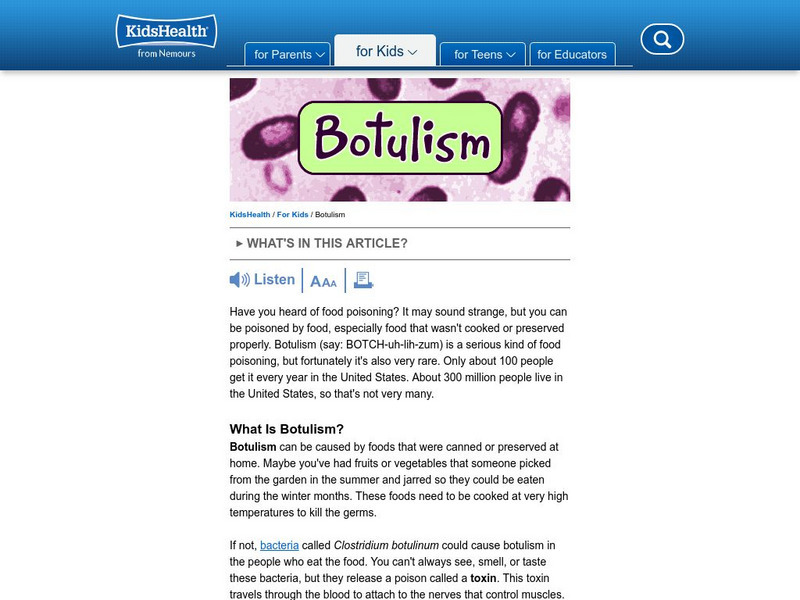Curated OER
Food Borne Illness PPT #1 - Introduction
What is food borne illness? How does food become hazardous? Your class members will learn about common symptoms of foodborne illness, as well as the chemical, physical, and biological hazards that can work to make food unsafe.
Curated OER
Food-Borne Illnesses
Use this instructional activity to have your charges consider the differences between food spoilage and food-borne illnesses including the differentiation of food infections and food intoxication, including characteristics of each. Some...
Curated OER
Microbes and Our Food
Students investigate foodborne illnesses and involved microbes. They identify major pathogens and then research and explain how they contaminate foods and how people are affected.
Curated OER
Food Poisoning
Young scholars study the prevention of the four major types of food poisoning. They write a letter of advice to an imaginary friend who has had food poisoning seven times within the last year.
Curated OER
Food Poisoning
Students study the bacteria that cause food poisoning using a written resource. They complete a research worksheet entitled, "America's Most Wanted." Next, they create a short skit about the causes, symptoms, prevention, and other...
Aetna Intelihealth
Aetna: Inteli Health: Gastroenteritis in Children
Thorough overview of gastroenteritis in children. Includes information on symptoms, prevention, treatment, and more.
Aetna Intelihealth
Aetna: Inteli Health: Gastroenteritis in Adults
Thorough overview of gastroenteritis. Includes information on symptoms, prevention, treatment, and more.
BioEd Online
Bio Ed Online: They're Everywhere: Bacteria
Bacteria are everywhere and can cause many different kinds of diseases. Bacteria are a major source of food contamination. Students will grow bacteria collected from different places and compare the results.
Other
Washington University School of Medicine: Botulism
Everything you could imagine about botulism. Very extensive information in outline format.
US Department of Agriculture
Food Safety & Inspection Service: Salmonella
Answers to many questions about the salmonella bacteria and its reputation as the #1 reported cause of foodborne illness.
Other
Virginia Department of Agriculture & Consumer Services: Food Safety
A comprehensive food safety site including information on food poisoning, food safety tips, a food safety quiz and a site for educating children on food safety.
Curated OER
Kids Health: Infant Botulism
Site provides an excellent description of botulism and how it affects infants, including information about symptoms, prevention and treatment.
Centers for Disease Control and Prevention
Centers for Disease Control: e.coli
Answers to the most frequently asked questions about E.coli.
Centers for Disease Control and Prevention
Centers for Disease Control: Salmonella
This resource general information including the most frequently asked questions about salmonella. Also technical information and links to articles about outbreaks.
Aetna Intelihealth
Aetna: Inteli Health: Food Poisoning
Thorough overview of food poisoning. Includes information on symptoms, prevention, treatment, and much more.
University of Nebraska
University of Nebraska State Museum: Poisons for Dinner?
You might be surprised to find out the poisons that are lurking in seven very common foods.
Other
Virginia State Department of Agriculture/consumer Sciences: About Food Poisoning
This site about food poisoning discusses Staphylococcus Aureus - what it is, where the common sources of "staph" are, common symptoms, and what can be done to prevent contamination and infection.
Mayo Clinic
Mayo Clinic: Food Borne Illness
This site from MayoClinic.com provides great information on food-borne illness. The article is somewhat brief, but provides an excellent overview on the subject.
Curated OER
Kids Health: Food Poisoning
Kids Health offers an easy-to-understand look at food poisoning with suggestions on how to avoid it.
Curated OER
Kids Health: Botulism
Keep yourself safe from botulism -- "a rare disease that affects nerves and the muscles they control." This article tells how botulism spreads and how it can be prevented.
Other
Cleveland Clinic: About Nausea and Vomiting
Read about what causes a person to exerience nausea and vomiting. This resource is organized in question/answer format and provides information on how to relieve nausea and control vomiting.
CK-12 Foundation
Ck 12: Life Science: Health of the Digestive System
[Free Registration/Login may be required to access all resource tools.] Most people have problems with their digestive system once in a while. These could be symptoms of foodborne illness, food allergies, or a food intolerance. Learn...
CK-12 Foundation
Ck 12: Life Science: Harmful Bacteria
[Free Registration/Login may be required to access all resource tools.] With so many species of bacteria, some are bound to be harmful. Harmful bacteria can make you sick. They can also ruin food and be used to hurt people. Learn more...
US Department of Agriculture
Usda: Dangers of Buffets
Buffets can be breeding grounds for germs causing foodborne illness. Clostridium Perfringens is commonly referred to as "cafeteria germ" due to prolonged exposure at incorrect temperatures. Read how to protect yourself.



